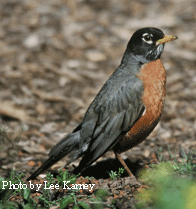
If a robin is very lucky it may live to be 14 years old. Because of how often this bird hunts on lawns, it is susceptible to chemical poisoning.
|
Robins Return
Every year about this time, you can find the familiar American robin returning from their wintering grounds in the southern United States and Central America. Males return about one week earlier than the females, and often come back to the same nesting area year after year. Robins will re-use their old nests, which can be found in trees or on buildings. A robin's nest is usually made of mud and plant material. The female is in charge of creating the nest, and will usually have two clutches of three or four eggs in it each year. She sits on the eggs for about two weeks, while the male defends the area. Of course the male will sit on the eggs every once and a while to give the female a break.
Once hatched, the young stay in the nest for about fifteen days, then it's time for the second clutch. The main diet of the robin is berries, along with insects, larvae, and worms.A robin's diet changes throughout the day. In the mornings they focus more on worms, but change over to berries later in the day.
Did you know? Even though a robin looks like he's "listening" for a worm when he cocks his head sideways, he's actually looking for tiny movements that would indicate a worm near the surface. Also, did you know that the American Robin (Turdus migraatorius) is in the thrush family, which also includes bluebirds?
Learn more: Cornell Lab of Ornithology
Track this bird's northward migrations: Journey North
Hear this bird's song of "cheerily, cheer up, cheer up, cheerily, cheer up."
|
